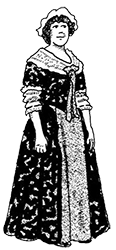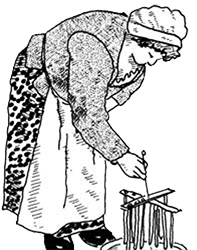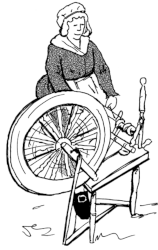Welcome! Did you find this page by scanning the QR code on one of our Collector Cards? If you did we hope you enjoyed the Scavenger Hunt at the event where you got the card. Here you can look at all our Units and their history.

The NWTA is organized into military units, each representing an actual regiment at a specific time during the American Revolution. Uniforms and accouterments are scrupulously researched, documented and reproduced. You will find rebels, Tories, mercenaries, frontiersmen, townsfolk, farmers, craftsmen, merchants and sailors from America, England, Germany and France.
A printable copy is available for download.
The Uniform of the 18th centry soldier
 Soldier illustration redrawn
Soldier illustration redrawnfrom G.A. Embleton/ Osprey.
A: HAT– Three cornered hats (called “cocked” hats) were typical with regular infantry, or battalion troops. Small leather caps were more common on skirmishers – rangers and light infantry units. British grenadiers and musicians often wore tall bearskin caps. Other military and civilian hats varied greatly.
B: COAT– Often highly decorated, the regimental coat was the 18th century soldier’s most distinctive feature. Most British regulars wore the familiar red coats. Artillery units of both sides wore dark blue or black, and green was worn by rangers on both sides. White, brown and various shades of blue were also worn, with blue becoming more common amongst Continental regulars as the war progressed.
C: FACINGS– The lapels, cuffs and collars of the regimental coat were usually of a different color than the coat. Color of facings varied between regiments and helped distinguish them from each other.
D: LACE– The tape decoration around the buttonholes and on the pockets was unique in design and placement to each European regiment.
E: CARTRIDGE POUCH– Most soldiers carried a tin canister or leather covered wood block on a shoulder strap. The cartridge pouch held prepared rounds of powder and lead rolled in paper tubes for fast loading and rapid fire. Smaller cartridge boxes were sometimes also worn on the belt.
F: WAISTCOAT– The long vest, or “weskit”, was worn by all decent men in public, the shirt being considered underwear. Regular troops of all participating nations usually wore white “small clothes”, which included the waistcoat and some sort of legwear (see below). Civilian small clothes were a variety of styles and colors.
G: LEGWEAR– “Breeches” were short, full-cut pants which fastened just below the knee. “Trousers” were ankle length pants, and “gaitered trousers” covered the shoe tops to keep out stones and debris.
H: LONGARM– Smoothbore flintlock muskets, the most common firearms of the day, were notoriously inaccurate, but fast loading and deadly in massed fire. Rifles were NOT common, but were employed for their accuracy at long distances by some light troops and frontiers people.
I: HAVERSACK– (Not visible) A linen shoulder bag used to carry food rations.
J: SIDEARM– Musket men carried bayonets, riflemen carried tomahawks and knives. Commissioned officers carried swords on either a waist or a shoulder belt.
K: SPLATTERDASHERS– Ankle-high spatterdashers or tall dark fabric “gaiters” with many buttons were common to European troops. Frontierspeople might employ gaiters or tall “leggins” made of blanket material or buckskin.
L: FOOTWEAR– Buckled shoes were common, though many had ties. Moccasins were not at all unusual, especially with frontier regiments.
-
In the 18th century the British army was home to some of the best-equipped and best-trained troops in the world. At the outbreak of the American Revolution in 1775 there were 8,000 British regulars already stationed in North America. By the end of the war more than 56,000 British and some 29,000 German troops would see service in America and the West Indies – not to mention many thousands of Loyalist troops and Indian allies.
The British regimental uniform was almost universally red and faced with any of various colors, depending on the regiment. Most wore white small clothes and a black cocked hat with their side arms and cartridge pouch on crossed white leather belts. Their primary weapon was the smooth-bore “Brown Bess” musket.
Units are listed chronologically by the period they portray.
Illustrations by Mark Tully, 55th Foot. -

1st Battalion Marines, 2nd Company – June 1775
A red regimental coat with white facings and the usual white waistcoats and breeches, with white cross belts, mark the 1st Marines in their shore uniforms. Aboard ship they would wear more typical sailors’ clothing called “slops” (see Virginia State Navy).
The primary function of Marines was to maintain shipboard discipline, although in June of 1776 they were aiding in the defense of Boston.
-

4th (King’s own) Rgt. of foot, Grenadier Co’y – November 1775
Tall bearskin miter hats, as well as the brass match case on the cartridge box strap and the wings on the shoulders of their coats, are typical to grenadier companies, the elite of the British army. Their coats are red faced blue, their small clothes are the usual white wool, and they wear tall black wool gaiters. Their uniform is in nearly perfect condition and in its idealized form, as it was on their arrival to Boston.
The 4th Grenadiers were at Lexington-Concord, at the outbreak of American Revolution, and were almost wiped-out recapturing Breed’s (Bunker) Hill at Boston.
-

55th Regiment of Foot, Captain Trevor’s Co’y – August 1776
Green facings on their red coats set the 55th apart in the NWTA. The uniform of the 55th reflects the classic British uniform for service in Europe, as yet not adapted to the rigors of American warfare.
The 55th fought at Long Island, Princeton, Brandywine, and Germantown, before being transferred to the West Indies where it saw heavy action against the French in 1778-1784.
-

Brigade of Guards, Grenadier Co’y – November 1776
The Guards Grenadiers have the typical grenadier match case and wings on their shoulders, but not the bearskin hat. Their coats are scarlet faced blue and have no lace. They wear white waistcoats and long trousers.
A brigade consists of several regiments acting under the command of a brigadier general, in this case the 1st, 2nd (Coldstream), and 3rd (Scots, pictured) Regiments of Foot Guards. The grouping of buttons on their lapels indicates the regiment.
The Brigade of Guards arrived in America in August of 1776, was captured at Yorktown in 1781, and was eventually released from prison in 1783. At the time portrayed, the Brigade was operating around New York.
-
42nd Royal Highland Rgt., Grenadier Co’y – January 1777
The 42nd wear the tall bearskin mitered hat that was common among grenadier units. Their short red coats are faced with blue, signifying a royal regiment. Red and white lace is on the shoulder wings, lapels and cuffs. They wear a belted plaid or kilt and diced hose. The cartridge box is worn at their waist and has a GR and crown on the flap.
The 42nd were active mostly in and around New York state and participated in the battles of New York, Brandywine, Germantown and others.
-
New York Volunteers – July 1777
The green coats and white facings of the New York Volunteers identify them as Loyalists to the British Crown. Five thousand such coats were supplied to the Provincials in spring of 1777, at which time the New York Volunteers were encamped at Kingsbridge, at the north end of Manhattan Island, and actively recruiting from Westchester County and the Hudson Highlands. They eventually became the Third American Regiment, at which time they were issued red coats with blue facings and sent to fight in the Southern Campaign until the end of the war.
-
71st Rgt of Foot, Fraiser’s Highlanders, Major’s Co’y – September 1777
Fraiser’s Highlanders wear short red coats faced white, topped by the traditional highlander’s bonnet as they were at the Battle of Brandywine. Trousers were considered more practical than kilts for service in America. Their leather waistbelts with single frogs for bayonet are black, unusual for British troops.
Fraiser’s entered the war in April of 1776 as the largest British regiment that served in the Revolution but suffered enormous casualties before returning to England in late 1783.
-
2nd Battalion of Light Infantry, 52nd Regiment, September 1777
In 1771 each British infantry regiment was required to select good men who were quick, agile and accurate marksman to create a company of light infantry. Today they would be known as special forces. They were adaptable in both dress and tactics. Their madder red coat is short and fitted rather than bulky. They wear close fitting gaitered trousers. Their hat has a narrow brim. All these uniform changes allow for unencumbered movement on the march and attack. The recreated unit represents troops during the Philadelphia Campaign; from the Battle of Brandywine (September 11, 1777) to Germantown (October 4, 1777). The 2nd Battalion earned their nickname, the “Bloodhounds,” after their nighttime bayonet attack on Continental General Anthony Wayne’s troops at Paoli.
-
Braunschweig Rgt. Prinz Friederich, Leib Kompanie – October 1777
The English Crown for a number of years been subsidized the armies of several German duchies. Six of these duchies (Hesse-Kassel, Braunswieg-Wolfenbüttel, Hesse-Hanau, Ansbach-Bayreuth, Waldeck & Anhalt-Zerbst) agreed to send troops to America to fight for the Crown in exchange for an agreement to continue the subsidies.
The Brunswick contingent landed in Canada in 1776, and helped drive the Congressional forces out of Canada, then participated in General Burgoyne’s campaign down Lake Champlain and the Hudson River. Rgt Prinz Friederich was one of the units left to garrison Fort Ticonderoga, avoiding surrender at Saratoga.
Rgt Prinz Friederich wears dark blue coats with yellow collar and cuffs, red turn-backs, and white metal buttons. A yellow and white pom-pon tops their cocked hat, identifying them as a Musketier regiment. The regiment was originally equipped with white woolen breeches and black gaiters, but due to the cold and dense undergrowth, they switched to overalls made from blue and white striped mattress ticking.
-
Fort St. Joseph Militia – July 1779
The Fort St. Joseph Militia wears civilian clothing with a wild mix of French and Indian influences: bright colors, moccasins, wooden shoes, fingerwoven sashes, and decorative silver broaches. Weapons and accouterments also reflect their frontier lifestyle and French heritage.
The militia at Fort St. Joseph, in what is now southwestern Michigan, was not an organized “permanent” militia, but rather a group of civilians acting as militiamen. At the time portrayed, they had joined forces with a detachment of the King’s 8th in an effort to forestall an impending attack on Detroit by George Rogers Clark. The French at Fort St. Joseph were deported to Michilimackinac by Governor Patrick Sinclair in June of 1780.
-
8th (King’s) Rgt. of Foot, General’s Co’y – July 1779
Dressed in red coats faced blue, white small clothes, tall black gaiters, and black cocked hats trimmed white, the 8th may be seen with their distinctive goatskin knapsacks. Painted canvas knapsacks were common for troops’ personal articles when on the march, but some German and British regiments chose goatskin.
The 8th Regiment covered the widest range of any regular British unit, from Montreal to the Mississippi River and Canada to Kentucky. They served on the frontier with Indians and loyalists from well before the war, 1768, until after the war’s end in 1785.
-
1st American Rgt. (Simcoe’s Queen’s Rangers), Light Company – October 1780
The light company, shown here, wears a short green jacket faced green, and a leather cap with a silver crescent symbolizing Diana, Goddess of the Hunt. They wear white trousers with spatterdashers, typical of light troops. Their caps sport feathers of white and black, the black worn in mourning for Major Andréwho was captured and hung for his part in Benedict Arnold’s betrayal.
The 1st American Regiment was originally raised during the Seven Years War by Robert Rogers and were better known as Roger’s Rangers. They were re-raised by Rogers in 1776 and served to 1784. Today they are part of the Canadian Army as the Queen’s York Rangers, 1st American Regiment.
-
Campeau’s Co’y, Saint Anne’s Militia, Bird’s Expedition – 1780
Campeau’s company wears a variety of civilian clothing that shows their frontier lifestyle and French heritage. Weapons and accouterments are also civilian in nature and vary greatly.
The Saint Anne militia was comprised of men raised along the Detroit River Region. Captain Bird led a British expedition into Kentucky that was supported by the local militia – including Campeau’s Company – and native Americans. The expedition resulted in the capture of Ruddle’s and Martin’s stations.
-
84th Rgt. of Foot, 1st Bat., Royal Highland Emigrants – March 1782
The 84th, in their government plaid and short red coats faced blue, look very much like the 42nd. Their blue highland bonnet, the style of lace on their lapels and cuffs, and the absence of shoulder wings are the primary differences. They wear white small clothes and a cartridge box and bayonet on their waist belt.
The 84th was the only highland regiment to be raised outside of Scotland. It was formed in 1775 from the families of the 42nd, 77th and 78th Highlanders, who had settled in Canada after the seven years war. Scottish emigrants from New York and North Carolina were also recruited.
-
Capt. Andrew Bradt’s Co’y, Butler’s Corps of Rangers – July 1783
Leather helmets and green regimentals faced red distinguish this notorious loyalist frontier regiment. Their waistcoats are also green, and their leg and footwear reflect the personal tastes and frontier experiences of the individual soldier. Butler’s preferred white neckwear over the more common black military stock.
Based at Fort Niagara, Butler’s Rangers terrorized the patriots of the northern frontier for the duration of the war.
-
17th Reg’t of Light Dragoons – March 1776
https://www.nwta.com
The regiment’s formation dates back to Wolfe’s victory at Quebec in 1759. At the breakout of hostilities, in 1775, the high character of the regiment occasioned it to be the first cavalry corps selected to proceed across the Atlantic, landing at Boston on the 24th of May. The regiment participated in fighting outside New York and succeeded in capturing American General Sullivan. It then took part in forcing the American evacuation of New York. The troop wears scarlet regimentals with 3-inch white lapels, white collar and cuffs. Their distinctive cavalry helmet is black leather with a white turban at the base; the plume and crest being scarlet and white. The helmet bears the death’s head (skull and crossbones) as does the regimental standard (flag) which also has the motto “Or Glory.”
-
When war finally broke out, the Colonists had no disciplined army that could match the British in open battle and very little military equipment. Militia regiments, despite generally large numbers, were rarely well trained and were usually only active within their own state boundaries. In 1775, Congress appointed George Washington Commander-in-Chief and the difficult task of putting together a regular army was begun.
Regiments were raised and equipped by individual states for Continental service, and color, style and condition of clothing and accouterments was anything but uniform. In 1779 Washington ordered all Continental troops to be outfitted with blue regimentals, faced with different colors to indicate the unit’ s origin. This order was carried out with moderate success.
Units are listed chronologically by the period they portray.
Illustrations by Mark Tully, 55th Foot. -
Pennsylvania Rifle Battalion, Capt. Hendricks’ Co’y – August 1775
This unit wears mostly civilian dress common along the Pennsylvania frontier fringed hunting shirts, leggings, moccasins, slouched hat and a variety of arms and accouterments.
The 90-man company was raised in Cumberland County, Pennsylvania in June of 1775 in response to an appeal from Congress for rifle companies to aid in the siege of Boston. In September of 1775, Hendricks’ Company accompanied Benedict Arnold’s expedition to Quebec, where Hendricks was killed and all but 18 men from his company were captured.
-
3rd New York Rgt., Capt. Lewis Dubois’ 4th Co’y – November 1775
Short gray regimental coats faced green illustrate one of the earliest uniforms of the Continental Army. Like many other early rebel units, the soldiers of the 3rd New York supplement their incomplete military issue with civilian items and surplus from the earlier war with France.
The 3rd New York served with Montgomery and Arnold on their unsuccessful campaign against Quebec in the winter of 1775-1776 and were mustered out of service in April 1776. The regiment was re-raised in 1776 and again in 1777.
-
Culpeper Minute Battalion – December 1775
Green fringed hunting shirts with ” Liberty or Death” across the chest make this unit instantly recognizable. Blue wool leggings and various civilian clothing completes their uniform and reflects the rural counties where they were raised. Their weapons are civilian as well, mostly rifles.
The Culpeper minute battalion was raised in Culpeper, Orange, and Fanquier counties in Virginia. They saw action at Hampton, Virginia and the battle of Great Bridge.
-
Capt. Alexander Hamilton’s New York Provincial Co’y of Artillery – September 1776
Dark blue coats with buff facings, buff waistcoats and leather breeches mark Hamilton’s artillery. Raised by the State of New York for the defense of New York City, they are unusually well uniformed, partly out of the pocket of their captain, the young Alexander Hamilton, later to become the first U.S. Secretary of the Treasury.
Hamilton’s Artillery is the only U.S. military unit of any type to have an unbroken line of service from the war of the Revolution to the present.
-
Virginia State Navy, of the Boat “Hero” – November 1776
Short, very loose pants called ” slops” and small hats, tarred for weatherproofing, were common, sensible clothing for sailors, no uniforms having yet been developed. The Virginia Navy wears red waistcoats as a sort of uniform article. The officers wear blue faced red, styled after the British naval officers’ uniform of the day.
The Congressional navy was woefully inadequate, and depended heavily on state supported navies and privateers operating under a Congressional ” Letter of Marque and Reprisal” for coastal defense. Children as young as six years old served aboard ships as powder monkeys and cabin boys.
-
Continental Marines, Dean’s Co’y – January 1777
A moss green coat faced white, and a black round hat trimmed white mark the Continental Marines. Their small clothes are white and there is a green stripe on the seam of their breeches. They also wear tall black gaiters. Dean’ s Company was raised late in 1775, fought as line troops in the second battle of Trenton, served with the artillery, but never saw service aboard a ship. Dean resigned his commission in July of 1777.
-
Captain Benjamin Logan’s Co’y, Kentucky Co. Militia – March , 1777
The British supplied arms, munitions, as well as occasional British regular troops and officers, to the Natives who launched attacks against the fledgling frontier settlements. By 1777, settlements in Kentucky had been reduced to Boonesboro, Harrodsburg, and Logan’s Fort- and only some 500 colonists. During March of 1777, the Company successfully defended Logan’s Fort against severe Indian attacks.
Logan sent a detachment to reinforce Boonesboro for the Siege in 1778. Some men of fought with Joseph Bowman in 1779 against the Indian town of Chillicothe, and Logan led his men with George Rogers Clark at the battle of Picaway, in August 1780. The men also saw service as “Over Mountain Men”, at the turning-point battle of Kings Mountain , S.C. The men wear traditional garments of the civilian frontier.
-
1st Regiment of Light Dragoon, Capt Henry Lee’s – 5th Troop – June 1777
The 1st Regiment of Light Dragoons, 5th Troop, (Virginia Light Horse) was raised in 1776 by Theodorick Bland and Captained by “Light Horse Harry” Lee. Thirty men joined Washington in New Jersey in December of 1776. Under Lee they were very successful in the early years of the war, highly praised by Washington and local press for their meritorious service. They served as Washington’s bodyguard in the Battle of Germantown.
Uniforms were blue wool regimental coats with red facings, red wool waistcoats, white leather breeches and leather high top boots. For head protection they wore black leather helmets with vertical shields and white horsehair crests.
-
4th Reg’t of the Massachusetts Line, Libbeus Ball’s Co’y, William Shepard’s Reg’t. – August 1778
The 4th Massachusetts Regiment also known as 3rd Continental Regiment was raised on April 23, 1775 under Colonel Ebenezer Learned outside of Boston, Massachusetts. The regiment would see action at the Battle of Bunker Hill, New York Campaign, Battle of Trenton, Battle of Princeton, Battle of Saratoga, Battle of Monmouth and the Battle of Rhode Island. Their regimental uniforms were blue faced white with the musicians wearing the reverse colors of white faced blue.
-
Capt. Joseph Bowman’s Co’y, Illinois Rgt., Virginia State Forces – August 1778
Raised in frontier Virginia for the defense of Virginia’s claimed Illinois Territory, Bowman’s Company served without uniforms. Their civilian clothing reflects the rigors of frontier life, and the ingenuity of early frontier people. Their service took them west to capture and garrison Cahokia on the Mississippi River, then on with George Rogers Clark to capture Vincennes.
-
4th Continental Rgt. of Light Dragoons (Dismounted service), Capt. John Craig’s Troop – July 1779
A visored leather helmet with a bearskin crest and green turban, tall boots and a red waistcoat make the 4th Continental Dragoons easy to identify. They may be seen in either their green regimental coat with red facings or fringed frock coats of various colors. Formed in 1777, the regiment served throughout the entire war.
Raised primarily in Pennsylvania, Maryland, and Virginia, they served in both the northern and southern campaigns. They had both mounted and dismounted troops.
-
Capt. Abraham Kellar’ s Co’y, Illinois Rgt. Virginia State Forces – January 1780
Kellar’ s company wears short, blue coats faced white, white small clothes, and black cocked hats. Note the tri-colored alliance cockade – black for the Continental Congress, white for France, and red for Spain. Kellar’ s carry a variety of arms and accouterments, some of Spanish origins. Kellar’ s Company saw service at Vincennes and the company was garrisoned there through the winter of 1779-1780. Abraham Kellar resigned his commission in 1781.
[box]
Greg Hudson, Unit Commander geh78@yahoo.com
Jon Andrews, Paymaster sianoil@hotmail.com
Elyon Davis, Recruiting Officer edavis@fieldandmain.com
https://sites.google.com/site/kellarscompany/home
Host unit of Locust Grove Market Fair
[/box] -
Webb’s Additional Rgt., Band of Musick – May 1780
Five to eight musicians in dark yellow coats faced red, with black cocked hats trimmed yellow, form the Band of Musick. Their coats are British musicians’ coats, captured with a supply ship full of uniforms bound for the British army in America. As part of its effort to uniform the army, captured British uniforms were often used by the patriot forces.
Regimental Musicians typically wore their regiment’ s coat and facing colors reversed. This officer’ s band of two oboes, two clarinets, two horns, and two bassoons played for military ceremonies, dinners, and dances. These musicians were all promoted to sergeant in May 1780.
-
Capt. Edward Worthington’s Co’y, Illinois Rgt. Virginia State Forces – October 1780
Worthington’ s wear short blue coats faced white, cocked hats bound white, and carry a variety of weapons and accouterments, many of which were provided by the Spanish. On their hats they wear a black cockade common to Congressional forces. Raised in 1778 of eastern farmers, Ohio Valley long hunters and French from the Illinois country, Worthington’ s were with Clark at Vincennes and saw action against Indians and French militia as well.
They fought in the engagement around St. Louis and Cahokia in late spring of 1780, and in October of that year, they were at the mouth of the Ohio on the Mississippi River defending Fort Jefferson against Chickasaw Indians.
-
Lauzun’s Legion – October 1781
Powder blue regimentals with yellow facings and very tall gaiters distinguish this ally of the rebel cause. The coat is long with short lapels and large pocket flaps, indications of the French origin of Lauzun’s Legion. They carry canteens made from gourds. The importance of the French contribution to American independence cannot be overstated.
After Burgoyne’s defeat in October of 1777, previously half-hearted support became generous, with major supplies of uniforms, weapons, troops, and even ships. The surrender of Cornwallis at Yorktown, the climactic battle of the American Revolution, could not have been won without the aid of both the French army and navy.
Lauzun’ s Legion defeated Tarleton at Gloucester Point, across the Chesapeake Bay from Yorktown, and thereby closed a possible escape route for the British Army.
-
2nd Virginia Rgt. – June 1782
The 2nd Virginia wears the standard uniform from the 1779 regulations for the Southern Division – blue faced red with white turnbacks, waistcoats and overalls. Their hats are black light infantry helmets, bound white. The 2nd was formed in the fall of 1775 and served from New York to Georgia for the duration of the war.
-
Commander in Chief’s Guard – September 1782
Dark blue regimentals faced buff with brass buttons, red waistcoats and gaitered trousers mark Washington’s Lifeguard. Their cocked hats are bound in white with the alliance cockade of black and white silk. All their clothes are in unusually good condition. The officer pictured here has a gorget at his breast, a red silk sash and a silver epaulet on his left shoulder, all symbols of rank, in this case a lieutenant. He also carries a spontoon.
The Commander in Chief’s Guard was formed March 12, 1776 at Cambridge Massachusetts, during the siege of Boston. It served as General Washington’s personal bodyguard, and as a training vehicle for the entire Continental army until June 6, 1783 when it’s duties were taken up by members of the New Hampshire Line.
-
10th Virginia Regiment, Nathan Reid’s Co’y, Continental Line – April – May 1779
Raised in the Piedmont counties of Virginia in 1777 as the 14th Vriginia Reg’t and was assigned to Weeden’s Bgd. of the Main Army. Assigned to Muhlenberg’s Bgd. as the 10th Virginia in Sept. 1778 with Wm. Davies as Colonel. Captured at Charleston in 1780. Uniform included a cocked hat with black lace and cockade. Issued a blue faced red French lottery coat, with white small clothes. Virginia stores also issued red flannel or serge weskits and blue or green broadcloth breeches. A Von Steuben IG report from May 1779 states: Arms and Accouterments in good order, clothing “very bad”, but in the best order and discipline possible.
-
Capt. John Holder’s Co’y of Boonesborough Militia, Fayette Co. Virginia
September 1778, during the Great Siege of BoonesboroughHolder’s Co’y wears civilian clothes common in the harsh frontier wilderness: moccasins, breechclout, leggings, hunting shirt, and round hat, etc. John Holder was a militia leader from 1777-1782 in Virginia’s Kentucky frontier counties. His company defended the settlement of Boonesborough and marched against the Indians north of the Ohio with Joseph Bowman and George Rogers Clark. Service was often mandatory–usually 40 days or until they returned—and the men were paid in either specie or plunder.
-
4th Connecticut Regiment, Fitch’s Company – June-July 1778
After heavy combat at Ft. Mifflin and Germantown in the fall of 1777, Fitch’s Company endures the winter at Valley Forge with the death of six men and only 20 of 44 men fit for duty by April of 1778. They spend the spring of 1778 cleaning and repairing clothing and equipment, with donations of civilian clothing from their neighbors in Connecticut. They have just learned Von Steuben’s new “German Exercise” and are in a high state of discipline and morale. The regiment fights well at Monmouth in June 1778. The 4th Connecticut soldiers wear linen overalls and a variety of waistcoats and jackets. A few men may wear hunting shirts, but most are still wearing the dark brown regimental coats with red facings and plain buttons that the State of Connecticut gave them in 1777.
-
Wayne’s Light Infantry Corp, Ashmead’s Company – July 1779
In 1779, Washington gave general orders for many of the regiments in the Continental Line to each form a light infantry company. These companies joined to create the Light Infantry Corp under General Anthony Wayne and participated in the July 16th midnight storming of Stony Point. They attacked the fort with bayonets only, gunfire being expressly forbidden, and wore white paper in their hats to recognize each other. The assault included Captain Jacob Ashmead with a company of light infantrymen from the 2nd Pennsylvania Regiment. Ashmead’s Company wore the French royal blue “Lottery” coats, with red facings, white turnbacks, and pewter buttons. Their light infantry caps included a black hair cockade. Because the men were recruited from different companies of the regiment, the rest of their clothing, accoutrements, and firearms varied.
-
Ship’s Company of the Frigate [USS] Boston, Cont’l Navy – January-June 1780, Charleston
The Continental frigate Boston was a 24-gun frigate, launched in Newburyport, MA in June of 1776, completed in 1777. Known as the most successful and longest serving ship in the Continental Navy, Boston captured more prizes than any other American vessel of the war. In 1778, commanded by Capt. Samuel Tucker, Boston carried John Adams to France. While there, she cruised European waters taking at least four prizes before returning to Portsmouth, NH. In 1779, she made two cruises in the North Atlantic capturing nine ships. In early 1780, Boston accompanied the American Squadron tasked with defending Charleston, SC, from British invasion. For a brief period, the guns from Boston were brought ashore and used in stationary batteries. When the city fell, in May 1780, Boston was handed over to the British. Renamed the HMS Charlestown, she would go on to serve with the British for another year in the North Atlantic before being assigned to escort merchant convoys to Canada from Britain. There she participated in the Battle of Louisburg (1781) where she narrowly escaped French capture and was laid up in Halifax for the rest of the year. She was sold out of British service in 1783. In its later years, the US Navy retroactively applied the “USS” designation to all Continental Navy ships, making USS Boston one of seven ships to bear that name.
-
Women, children, sutlers, and other non-military personnel commonly accompanied 18th-century armies on campaign.. Without the efforts of these trades people and campfollowers,the war machines of both sides would have quickly ground to a halt. In addition,our civilian camp presents aspects of 18th century life away from the military camps, representing people of the towns and farms of the colonies.
-
Women and Children in the Army
During the American Revolution, it was common for women and children from both sides to follow their husbands into war. This was done by all classes of women from the very wealthy – who just visited their husbands in the field from time to time – to the common, everyday women who had no other means of support and no place else to go.
The British army officially allowed one woman for every six men, or one per tent. The Continental army had similar ratios, but in both armies this quota was often exceeded. They were known as “women on the ration” and received one-half of what ever the army gave a soldier. Useful children received a one-quarter ration. They had jobs in the army, such as mending clothes, taking care of the sick men, doing laundry, and cooking. A few even followed the army out on the battle field to bring water and ammunition to the men.
-
Philadelphia Ladies Association – June 1780
Thirty-six prominent Patriot women organized a major fundraising campaign for the relief of impoverished patriot troops, urging women to forgo luxuries and frivolities and donate to the cause. Over $300,000 continental dollars were raised and at General Washington’s insistence linen was purchased and 2200 shirts were made to supply the desperate need of the soldiers.
-
Sandridge Settlers of Albany-Town, New York
Although Albany was still predominantly Dutch, by the late 18th century it had become a center of international trade attracting immigrants from the British Isles, France, Poland, Germany and Denmark.
The residents of Albany Almshouse demonstrate a variety of skills influenced by the Old-World traditions.
-
Civilians
Set aside from the military camp you will meet various people depicting the daily life of the town’s folk and farmers during the conflict. What was it like living in an area controlled by the British if you supported the Congressional forces or the other way around? Members research and demonstrate skills and trades you would find in the towns or on the farm such as weaver, lace maker, blacksmith, gunsmith, brewer or fisherman. You may see processing of fibers for cloth, foods available as well as cooking and preserving food. You will also hear music of the era.

 Facebook
Facebook


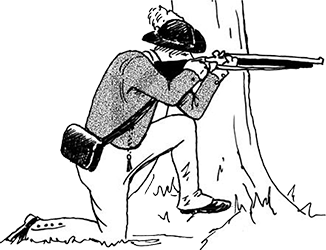
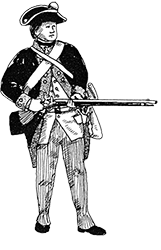





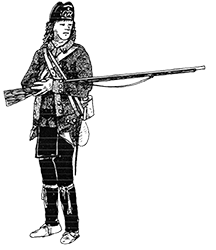
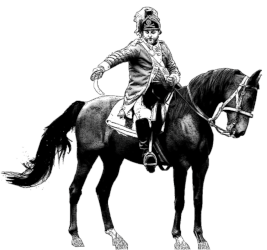
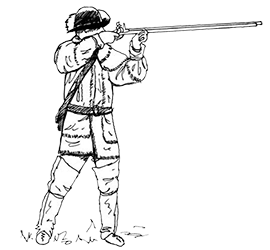
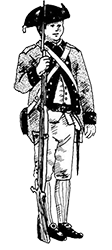
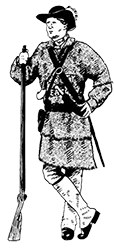
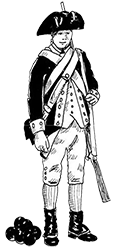


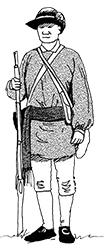
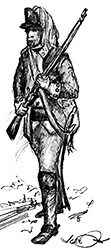
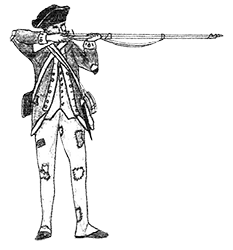






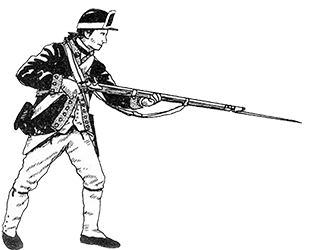

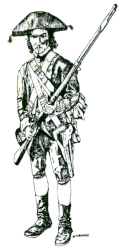
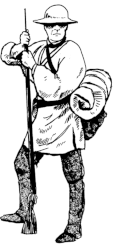

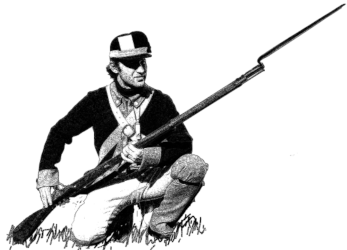
![Ship’s Company of the Frigate [USS] Boston](/wp-content/uploads/2023/02/congressional-shipscompany.png)
